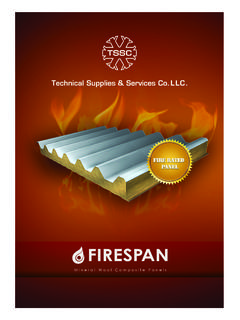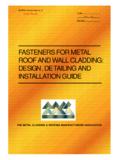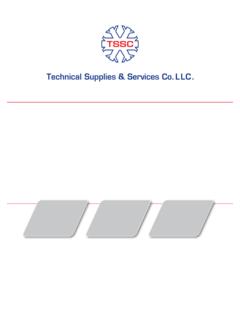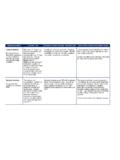Transcription of GUIDANCE NOTE No. 10 Waterproofing of Metal …
1 (Issued February 2014) Page 1 of 5 GUIDANCE NOTE No. 10 waterproofing of metal profiled sheet Roofing and cladding The coating of profiled sheet roofs in order to extend the Waterproofing life of such structures has long been within the realms of the liquid roof Waterproofing industry. This GUIDANCE Note highlights some of the issues that need to be taken into consideration when undertaking this type of work. profiled roofs may contain fragile materials and all works must be conducted in accordance with the requirements of the Green Book ACR[CP]002:2012i. No attempt to inspect or work on a fragile roof or walkway on the roof should be undertaken by walking along lines of fixings.
2 A full roof survey will establish any problems that exist with the existing roof. Some common issues with this type of structure include; Loose fixings and fasteners Cut end corrosion of Metal sheets Missing profile filler pieces Ridge and Eaves Translucent sheet deterioration or failure Poor detailing to roof projections- Pipes, Vents, etc. Moss/lichen build up on fibre cement sheets Leaking gutters There are many criteria about the existing roof construction that need to be established about the existing roof. Is it a Metal profile sheet roof or is it an asbestos or other fibre cement sheet roof? These products present different problems when it comes to the type of treatment required as well as presenting different health and safety issues.
3 Knowledge of the actual roof structure would also be an advantage when it comes to decision making about the type of detailing required on the project. Is it single skin, twin skin, or composite panel? What is the lining panel Metal , plasterboard, or asbestos? Is there any insulation between the lining panel and the outer skin? Condensation Installing a seamless Waterproofing skin over the existing structure may create a situation where condensation problems are going to be exacerbated. Depending on the roof structure and the building use, ventilation may have to be introduced into the structure. Metal profiled Sheets When dealing with Metal profile roof sheets it is important to identify the actual protective coating.
4 Plastisol, PVF2 etc. are just some of the different types of profile sheet finishes that may need different preparation and priming products depending on the coating specification proposed. 1. Introduction 2. Fragile Materials 3. Roof Survey 4. Points to Consider (Issued February 2014) Page 2 of 5 Most Metal profiled sheets when leaking will generally show in the gutter area of the roof, so good practice would be to waterproof the gutter prior to carrying out the Waterproofing to the profiled sheets. Even in a twin skin structure the leaks in the roof can end up showing at the gutter area. All the faults identified in the survey need to be rectified prior to the application of the new roof coating specification.
5 Fixings Fixings are probably the main reason for water ingress in this type of roof. Over the years the sealing washers (Rubber, Neoprene etc) will have deteriorated and perished. The fact that some of the washers will have perished will mean that some of the fixings will be loose which in turn will allow water ingress. Many of the fixings will also be affected by rust and will prove difficult to tighten up. All the fixings should be wire brushed and given individual treatment in accordance with the coating manufacturer s specification, this would generally involve the application of a reinforcement which would be bedded in the coating material prior to the application of the full coating specification.
6 The number of fixings should also be checked. If the fixing spacings are not adequate, flexing of the roof sheets can occur when operatives access the roof for maintenance or during coating. If this occurs it can be extremely difficult to properly detail over the fixings themselves and also side and end lap joints. Lap Joints A properly constructed pitched Metal profile roof should have 150mm minimum end laps sealed with two butyl sealant strips as detailed in Metal cladding & Roofing Manufacturers Association (MCRMA) Technical Paper No. 6 profiled Metal Roofing Design Guideii, which states The lower run is the primary weather seal and should be positioned as close as possible to the edge of the top sheet .
7 The upper seal is to prevent moisture entering the overlap from inside the cavity . Not all roofs have been constructed to these standards and this should be determined at survey stage. Cut End Corrosion The degree of cut end corrosion can vary enormously and if too prevalent the profiled sheet may need to be completely replaced. All rust should be removed by wire brush or grinding wheel to get to bright Metal if possible. Rust inhibitors should be applied prior to the application of a Metal primer. A flexible reinforcement is then generally applied to account for expansion and contraction between the top and bottom profiled sheet . Some specifications may need the addition of bond breaks in order to account for excessive movement at sheet end laps but this should be checked with the coating manufacturer.
8 The roof coating specification is then applied taking care to adhere to the manufacturers priming requirements and coverage rates. Reverse side corrosion Over the last 20 years, some cut edge corrosion systems have been routinely used on PVC plastisols, including many based on silicone technology. If the repair system used is not breathable, it is possible that condensation will have occurred on the underside of the roof sheets. Liquid can then collect just above the cut edge sealed joint detail and reflux as the sheet heats and cools from direct sunlight. There is then a possibility that corrosion can be promoted from the reverse side of the roof sheet .
9 This is potentially impossible to treat as there is no way of accessing and preparing the sheet reverse side. Tell-tale signs are as follows: 1. Existing cut edge repair is visible but rust staining is weeping from the repairs 2. Corrosion blisters are seen in the sheet above the joint (usually before the first fixing above 3. In extreme cases, the sheet will be visibly corroded. (Issued February 2014) Page 3 of 5 For safety s sake, if any of the above signs are noted, then this roof area should not be approached as there is a danger of the roof sheet giving way under loading. The only options for treating this defect is either re-sheeting or removal and replacement of the bottom edge of the profile Metal sheeting.)
10 When approaching this type of work, it is important to clarify the objectives. Is the client wanting a protective treatment for the cut end corrosion if so, use a system that doesn t seal the joints. If the client is expecting a full Waterproofing treatment, then the potential issue above needs to be referred to. Loose and missing profile fillers Many profiled sheet roofs suffer from problems that affect the profile filler pieces at ridge and eaves details. They may have either perished, worked loose over the years or have been removed by birds. This allows wind driven rain to blow under the capping and into the structure, eventually showing as water ingress at sheet laps or the gutter area.






